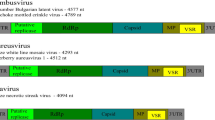Abstract
Circomics (circular DNA genomics), the combination of rolling circle amplification (RCA), restriction fragment length polymorphism (RFLP) analysis and pyro-sequencing, has been used recently to identify geminiviruses with high efficiency and low costs. Circular DNAs associated with Cuban geminiviruses were characterised by RCA/RFLP analysis and 454 sequencing of two batches of DNA amplified from selected plant samples as well as individual cloning and Sanger sequencing of DNA components and compared to other geminiviral DNAs by phylogenetic analysis. Cuban geminiviruses that were closely related to each other challenged the circomics approach. Ten geminiviral components and one alpha-satellite DNA were determined and compared to three geminiviral components obtained by conventional cloning. New strains of Sida yellow mottle virus (SiYMoV), tomato yellow distortion leaf virus (ToYDLV), Sida golden mosaic Florida virus (SiGMFV) and Sida golden mosaic Liguanea virus (SiGMLV) are described with host plant species being classified by molecular PCR-based bar coding. A new virus species is named Peristrophe mosaic virus. The first alpha-satellite found in Middle America establishes the New World branch of these elements which are related to nanoviruses and were previously thought to be restricted to the Old World. In conclusion, circomics is efficient for complex infections and closely related viruses to detected unexpected viral DNAs, but may need some scrutinisation by direct sequencing and cloning of individual components for certain cases.






Similar content being viewed by others
Notes
The terminology of America's subdivisions is quite complex and influenced by political and cultural conditions. Here, we refer only to the geographical term Middle America which includes the region south of the USA and north of Colombia/Venezuela in our description (see http://en.wikipedia.org/wiki/Americas_(terminology) for alternatives).
References
H. Jeske, in Torque Teno Virus: The Still Elusive Human Pathogens, ed. by H. Zur Hausen, E.-M. de Villiers (Springer, Berlin, 2009), pp. 185–226
P.S. Wyant, S. Strohmeier, B. Schäfer, B. Krenz, I.P. Assunção, G.A. de Andrade Lima, H. Jeske, Virology 427, 151–157 (2012)
C. Hagen, A. Frizzi, S. Gabriels, M. Huang, R. Salati, B. Gabor, H. Huang, Arch. Virol. 157, 907–915 (2012)
R.W. Briddon, J. Stanley, Virology 344, 198–210 (2006)
T. Paprotka, V. Metzler, H. Jeske, Virology 404, 148–157 (2010)
G. Romay, D. Chirinos, F. Geraud-Pouey, C. Desbiez, Arch. Virol. 155, 1843–1847 (2010)
B. Gronenborn, Vet. Microbiol. 98, 103–109 (2004)
H. Jeske, M. Lütgemeier, W. Preiss, EMBO J. 20, 6158–6167 (2001)
W.J. Kress, K.J. Wurdack, E.A. Zimmer, L.A. Weig, D.H. Janzen, Proc. Natl. Acad. Sci. USA 102, 8369–8374 (2005)
T.A. Hall, Nucl. Acids Symp. Ser. 41, 95–98. http://www.mbio.ncsu.edu/BioEdit/BioEdit.html (1999)
T. Hall, GERF Bull. Biosci. 2, 60–61 (2011)
M.A. Larkin, G. Blackshields, N.P. Brown, R. Chenna, P.A. McGettigan, H. McWilliam, F. Valentin, I.M. Wallace, A. Wilm, R. Lopez, J.D. Thompson, T.J. Gibson, D.G. Higgins, Bioinformatics 23, 2947–2948 (2007)
K. Tamura, D. Peterson, N. Peterson, G. Stecher, M. Nei, S. Kumar, Mol. Biol. Evol. 28, 2731–2739 (2011)
T. Paprotka, L.S. Boiteux, M.E.N. Fonseca, R.O. Resende, H. Jeske, J.C. Faria, S.G. Ribeiro, Virus Res. 149, 224–233 (2010)
H. Jeske, D. Gotthardt, S. Kober, J. Virol. Methods 163, 301–308 (2010)
C. Wege, R.D. Gotthardt, T. Frischmuth, H. Jeske, Arch. Virol. 145, 2217–2225 (2000)
J. Schubert, A. Habekuß, K. Kazmaier, H. Jeske, Virus Res. 127, 61–70 (2007)
P.S. Wyant, S. Kober, A. Schwierzok, C. Kocher, B. Schäfer, H. Jeske, C. Wege, Virus Res. 167, 397–403 (2012)
E. Fiallo-Olive, Y. Martinez-Zubiaur, E. Moriones, J. Navas-Castillo, Arch. Virol. 155, 1535–1537 (2010)
E. Fiallo-Olive, J. Navas-Castillo, E. Moriones, Y. Martinez-Zubiaur, Arch. Virol. 155, 2053–2058 (2010)
Y. Martinez, C. deBlas, I. Zabalgogeazcoa, M. Quinones, C. Castellanos, E.F. Peralta, J. Romero, Plant Dis. 81, 1215 (1997)
Y.M. Zubiaur, C. de Blas, M. Quinones, C. Castellanos, E.L. Peralta, J. Romero, Arch. Virol. 143, 1757–1772 (1998)
C.M. Fauquet, R.W. Briddon, J.K. Brown, E. Moriones, J. Stanley, M. Zerbini, X. Zhou, Arch. Virol. 153, 783–821 (2008)
P. Lotrakul, R.A. Valverde, A.D. Landry, Phytopathology 90, 723–729 (2000)
C. Ha, S. Coombs, P. Revill, R. Harding, M. Vu, J. Dale, J. Gen. Virol. 89, 312–326 (2008)
C. Ha, S. Coombs, P. Revill, R. Harding, M. Vu, J. Dale, J. Gen. Virol. 87, 997–1003 (2006)
A.M. Idris, M.S. Shahid, R.W. Briddon, A.J. Khan, J.K. Zhu, J.K. Brown, J. Gen. Virol. 92, 706–717 (2011)
V. Zaffalon, S.K. Mukherjee, V.S. Reddy, J.R. Thompson, M. Tepfer, Arch. Virol. 157, 483–495 (2012)
P.S. Wyant, D. Gotthardt, B. Schäfer, B. Krenz, H. Jeske, Arch. Virol. 156, 347–352 (2011)
R.W. Briddon, B.L. Patil, B. Bagewadi, M.S. Nawaz-ul-Rehman, C.M. Fauquet, BMC Evol. Biol. 10, 97 (2010)
E. Regel, in Gartenflora, ed. by E. Regel (Ferdinand Enke, Stuttgart, 1875), pp. 116–117
C.W. Bennett, The Curly Top Disease of Sugarbeet and Other Plants (American Phytopathological Society, St. Paul, 1971)
K. Saunders, I.D. Bedford, T. Yahara, J. Stanley, Nature 422, 831 (2003)
S. Garcia-Andres, D.M. Tomas, S. Sanchez-Campos, J. Navas-Castillo, E. Moriones, Virology 365, 210–219 (2007)
S. Duffy, E.C. Holmes, Appl. Environ. Microbiol. 73, 7114–7117 (2007)
A.M. Idris, A. Abdel-Salam, J.K. Brown, Plant Dis. 90, 1262 (2006)
M. Quinones, M.E. Fonseca, Y. Martinez, G.P. Accotto, Plant Dis. 86, 73 (2002)
K. Saunders, I.D. Bedford, J. Stanley, J. Gen. Virol. 83, 907–913 (2002)
E. Fiallo-Olivé, Y. Martínez-Zubiaur, E. Moriones, J. Navas-Castillo, Virology 426, 1–6 (2012)
K. Rosario, P. Padilla-Rodriguez, S. Kraberger, D. Stainton, D.P. Martin, M. Breitbart, A. Varsani, Virus Res. 171, 231–237 (2013)
Acknowledgments
The authors like to thank Drs. Björn Krenz, Arvind Varsani and Christina Wege for critical reading of the manuscript. We are grateful to Kerstin Kläring (Technical Head of the Botanical Garden Berlin-Potsdam) for providing Peristrophe speciosa plants. This research was supported by the ERA-PG programme (RCA Genomics, BMBF 0313986).
Author information
Authors and Affiliations
Corresponding author
Electronic supplementary material
Below is the link to the electronic supplementary material.
Rights and permissions
About this article
Cite this article
Jeske, H., Kober, S., Schäfer, B. et al. Circomics of Cuban geminiviruses reveals the first alpha-satellite DNA in the Caribbean. Virus Genes 49, 312–324 (2014). https://doi.org/10.1007/s11262-014-1090-8
Received:
Accepted:
Published:
Issue Date:
DOI: https://doi.org/10.1007/s11262-014-1090-8




